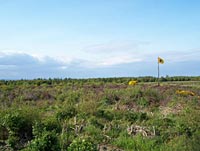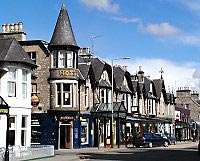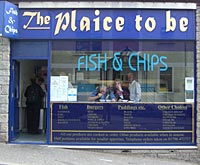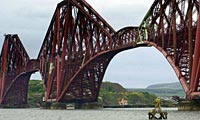Scotland's Islands & Highlands Tour Diary
Day 11 : Back to Inverness,
Edinburgh and Glasgow
|
|
Our last ferry ride was on the largest of Calmac's ferries |
An early morning ferry
ride, a bonus side trip to Culloden, and the completion of
the tour.
Part
of an 11 day/page trip diary - click the links on the right
hand side for the other days in this diary. |
Jeanette and her husband Ken
were on our 2010 Scotland's Islands and Highlands Tour, and
Jeanette kept a detailed day by day diary of the tour.
She has very graciously allowed
it to be re-published here, so as to allow you an unvarnished
view into what the tour was all about.
The text is hers, which I've
respected and not changed apart from a few subheadings and extra paragraph
breaks and some Americanizations of her English spelling (they
are from New Zealand).
I've sourced the pictures and
their captions are also from me, not Jeanette.
You can follow along with her
narration by tracking the tour on this
tour
itinerary page and the linked Google maps.
I hope this will encourage you
to come on our
2011 Scotland's Islands and Highlands Tour.
Day 11 – Tuesday June 24th
2010 – Stornaway (Isle of Lewis) to Glasgow
Google Touring Map for the Day
The alarm woke us up at 5am.
We had just enough time to get dressed, get the bags to the bus
and have a light breakfast (prunes, grapefruit and yoghurt)
before getting on the bus ready to leave at 6:05am. It was cold
this morning but at least the sun was shining.
We had quite a
long wait before our coach could board the ferry at 6:35am for
the sailing at 7am. Our ferry today was the 'Isle of Lewis'
which is the largest ferry in the CalMac fleet holding 123 cars.
We went up to the Observation Deck and had a good view of the
town and Lews Castle as we sailed out of the sheltered Stornoway
Bay.
It was windy crossing the Minch Bay but this ship hardly
moved in the waves. Ken bought me a cup of hot chocolate which
helped my throat (£2.10). I was very keen to visit Culloden
Field, near Inverness so I asked David if we could detour there.
He said if I got at least half the group to agree to reducing
the lunch stop in Pitlochry from 1.5 hours to 1 hour then we
could do it. I walked around the ship finding members of our
group to get their agreement and had no resistance from anyone
so hoped David would still agree.
We arrived in the port of
Ullapool on the mainland, a very sheltered inlet, about 9:40am.
The town used to be a booming herring fishing centre but now it
is only a ferry terminal.
David distributed a small dram of
whisky to all who wished to drink some. Ken shared his with me.
David had bought a book “Scottish Miscellany” and read a number
of short items including 2 poems from “The World's Worst Poet”
(Scotland's Worst). This entertained us for many miles. By 11am
we were entering the city of Inverness, at the northern most
point of “The Great Glen”. We left Jane and Charlie at the
railway station so they could get the train to London.
David said we had time to
visit Culloden Moor so that was our next stop at 11:15am. This
is where the 1746 battle took place between the Jacobites
(fighting for Bonnie Prince Charlie) and the British (both
English and Scottish). The battle lasted only 1 hour with the
death of more than 1000 Jacobites and was the effective end of
the Jacobite era. It was the last hand-to-hand battle fought on
British soil. Within a few days of the battle, around 1,500
Jacobite soldiers gathered at Ruthven Barracks in the mountains
south of Aviemore, ready to continue the campaign. Awaiting them
was a message from Bonnie Prince Charlie saying that 'each man
should save himself the best he could'. For him, the Rising was
over. Unopposed, the government sent its army and navy across
Scotland, punishing anyone suspected of Jacobite sympathies.
With a policy of
'pacification of the Highlands', the government began to
dismantle the structures of Highland society. Chiefs were
deprived of their legal powers and clansmen of their weapons.
Jacobite estates were seized by the Crown. The kilt and tartan
were banned. The Disarming Act was passed by the Government and
all weapons had to be surrendered. Even bagpipes were considered
a war weapon and were destroyed and some Pipers were executed.
Bonnie Prince Charlie evaded the British for about five months
by seeking refuge in the Highlands of Scotland before fleeing to
the Isle of Skye and then to France (with the help of Flora
McDonald) where he was welcomed as a hero of Europe. The story
of his bold expedition and romantic escape made him the biggest
celebrity of his time. His life afterwards was one long
anti-climax. He was expelled from France in 1748 and spent the
next decade involved in futile conspiracies. He died in Rome
(his birthplace) in 1788, a broken alcoholic, deserted by his
wife and followers.
I was keen to visit the
field as I had read about it in the first book by Diana Gabaldan
called Outlander (called Cross Stitch in the UK). Anyone
interested in historical fiction and Scottish and American
history in the 18th century would find her 9 books in the
Outlander series interesting reading. I walked out to the
government line (defined with red flags) then back to the
Leanach cottage which is the only surviving building after the
battle and was inhabited until 1912. Unfortunately I could not
see inside the cottage as it was closed for the roof to be
re-thatched.
|

Culloden moor; the yellow flag denotes the
furtherest advance of the Highland charge. |
The moor is very flat with the government lines
marked with red flags, nearest the visitor centre, and the Jacobite line with blue flags away in the distance.
On the way back to the bus I
met a man in the uniform of a French soldier. There were about
300 French soldiers who provided a second line of defence behind
the Jacobites. Most were taken prisoner then swapped for British
prisoners held in France. He was very friendly and informative
and helped to bring the battle to life for me. Each time he
'works' here he dresses in a different uniform and represents
that soldier's life in the battle.
Many thanks to David for
allowing us to visit the field. I was most grateful and greatly
enjoyed the experience even though I found my cough and throat
to be very difficult to deal with as well as having a stuffy
nose.
At 11:40am we were on the
road again on our way to Edinburgh. We crossed the Slochd summit
(1328m/405') then into the Cairngorm National Park. The hills
were all covered with heather or pine trees. We drove past
Aviemore where Ken and I had stayed many years ago on a
self-drive tour of Scotland. This is a major skiing area in the
winter.
Just south of Aviemore we passed the Ruthven Baracks
where the last of the Jacobites met on the day after the
Culloden battle. We passed Dalwhinnie distilleries which is the
highest level distillery in the UK. Unfortunately for the whisky
drinkers, no time to stop.
We could see impressive
Blair Castle through the trees as we passed but could not get
any photos. In 1740 the 2nd Duke of Atholl transformed the
original medieval structure into a stylish home of the period,
removing the turrets and battlements and applying fashionable
Georgian finishes.
Queen Victoria fell in love with this house
when she visited in 1844 and it was on this occasion that she
was so impressed with the guard provided by the Atholl
Highlanders that she granted them the right to bear arms. Hence
Blair castle has the only private army in the UK, largely for
ceremonial purposes now. The 7th Duke of Atholl in 1860s/70s
re-added the battlements and turrets and a magnificent ballroom
which is still used today for many Highland balls, banquets and
functions.
|

Pitlochry. |
At 1:25pm we stopped in
Pitlochry for lunch. It was a very interesting town with a lot
of tourists and at least 6 tourist buses in the car park. The
Blair Atholl Distillery here has its own hydro electric power
station.
We joined David and Oren in “A Plaice to Be” fish and
chip shop and enjoyed a piece of salmon, a piece of cod and a
lot of chips sitting at a long counter looking out onto the
street watching the people walking past (£10.50).
|

Jeanette and Ken eating their fish and chips in
Pitlochry. |
We only had
time to look in a few shops then I went to the toilet (30p)
before re-boarding the bus.
At 2:30pm we were on our way
again. David commented that the weather we were having today
(patchy cloud and occasional showers) was the weather he had
been expecting for the whole tour. We had been extremely
fortunate to have had such great weather and calm seas.
We
passed near Scone Palace where the Stone of Scone originally
resided. It had been used for all coronation ceremonies in
Scotland since 1057 until 1296 when Edward I of England took the
stone and installed it in the golden coronation chair in
Westminster Abbey. Since then all English monarchs and since
1707 nearly all British monarchs have been enthroned on this
seat.
In 1950, four students
removed the Stone from Westminster Abbey in London. It soon
turned up at Arbroath Abbey, north-east of Edinburgh. The abbey
is famous for the Declaration of Arbroath, a robust statement of
Scotland’s independence from England. The stone was returned to
Westminster Abbey.
In 1996, Her Majesty Queen Elizabeth II
allowed the stone to be returned to Scotland, to Edinburgh
Castle, after 700 years. Its royal role will continue as the
ancient stone will be taken to London for all future
coronations.
Once we were on the M90
there was a lot more traffic. It became quite windy with heavy
black clouds on the horizon but no rain yet. We crossed the
Firth of Forth bridge and could see the railway bridge under
renovation but still recognizable.
|

The very distinctive - some would say very ugly -
Victorian built Firth of Forth railway bridge. |
It is the 2nd longest
cantilever bridge in the world (after the Quebec bridge) and is
internationally recognized as a Scottish Landmark. As we
approached Edinburgh David told us that its original name was
Dunedin and that name has been retained as the city of Dunedin
in the South Island of New Zealand. Edinburgh was often referred
to as 'Auld (old) Reekie' due to the horse manure that was prevalent in
the city in days gone by.
At about 4pm we pulled up at
the Edinburgh railway station and said goodbye to David and a
number of others leaving the tour here. Jay then became our
guide as we drove along Princes Street on our way to Glasgow.
There was a lot of traffic in the city streets so Anne Marie
asked Jay whether he preferred driving in Edinburgh city or the
single lane roads in the Hebrides. Jay said 'no contest', he
preferred single lane roads any day. The annual Royal Highland
Show started today at Inglaston Show grounds and we saw the huge
car park very full as we drove past.
We arrived at Glasgow
railway station at 5:25pm and saw Davie (our Scottish cruising
friend David Hughes) walking towards our coach as we got off. It
was perfect timing as he had just arrived too. We said goodbye
to everyone and special thanks to Jay for his friendship and
great safe driving. I was feeling fairly miserable today with my
cough, which was now deep in my chest, so it was not such a good
finish to an otherwise wonderful tour of the Scottish Hebrides
Islands.
The following day Davie and
Genevieve took me to their Doctor who gave me some antibiotic
for a slight chest infection. I rapidly improved over the next
week and could look back on a great 11 day tour but would still
rather be on a ship than on a land tour.
Read more in the rest of
Jeanette's Diary
See the links to each day
of the eleven day tour/trip diary at the top
right of this page.
|
If so, please donate to keep the website free and fund the addition of more articles like this. Any help is most appreciated - simply click below to securely send a contribution through a credit card and Paypal.
|
Originally published
7 Jan 2011, last update
30 May 2021
You may freely reproduce or distribute this article for noncommercial purposes as long as you give credit to me as original writer.
|

